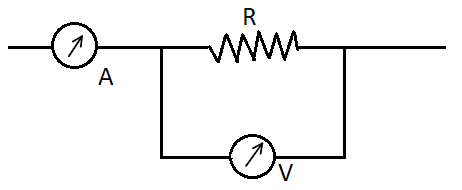
In the following diagram ammeter reading is $ 4A $ , voltmeter reading is $ 20V $ , the value of $ R $ is:

A) $ > 5\Omega $
B) $ < 5\Omega $
C) $ = 5\Omega $
D) $ \leqslant 5\Omega $

Answer
485.7k+ views
Hint :Ammeter is a device that is used to measure the amount of electric current flowing through a conductor. Voltmeter is a device that is used to measure the potential difference across two points in a conductor.
Complete Step By Step Answer:
An ammeter is a device which is responsible for the measurement of electric current flowing through a conductor. It measures electric current in amperes $ \left( A \right) $ . Ammeter is always attached in series with the conductor in order to find the correct reading.
A voltmeter is a device which is responsible for the measurement of potential difference or voltage across two points in a conductor. It measures voltage in volts $ \left( V \right) $ . Voltmeter is always attached in parallel with the conductor to find the correct reading.
Whenever a parallel circuit is introduced in an existing circuit, the current flowing through the original wire splits in inverse ratio of their resistances. Which implies that in this case a minute amount of current will flow through the voltmeter.
Now, according to ohm’s law,
$ V = iR $
Where, $ V = $ potential difference
$ i = $ electric current
$ R = $ Resistance
Also, let the current flowing through the resistance be $ {i_O} $ and the current flowing through the voltmeter be $ {i_1} $ , so that
$ i = {i_O} + {i_1} $
Now for the resistance $ R $ , we know that,
$ V = 20V $
$ \Rightarrow 20 = {i_O}R $
$ \Rightarrow 20 = (i - {i_1})R $
$ \Rightarrow 20 = (4 - {i_1})R $
$ \Rightarrow R = \dfrac{{20}}{{4 - {i_1}}} $
The above equation clearly states that the resistance will be greater than what would have been if the current did not split, that is resistance is greater than $ 5\Omega $ .
Thus option A is the correct answer.
Note :
When different resistors are connected in series, the current flowing through them remains constant whereas the potential difference across each resistor differs. But when different resistors are attached in parallel, the potential difference across each resistor remains constant but current flowing through each resistor differs.
Complete Step By Step Answer:
An ammeter is a device which is responsible for the measurement of electric current flowing through a conductor. It measures electric current in amperes $ \left( A \right) $ . Ammeter is always attached in series with the conductor in order to find the correct reading.
A voltmeter is a device which is responsible for the measurement of potential difference or voltage across two points in a conductor. It measures voltage in volts $ \left( V \right) $ . Voltmeter is always attached in parallel with the conductor to find the correct reading.
Whenever a parallel circuit is introduced in an existing circuit, the current flowing through the original wire splits in inverse ratio of their resistances. Which implies that in this case a minute amount of current will flow through the voltmeter.
Now, according to ohm’s law,
$ V = iR $
Where, $ V = $ potential difference
$ i = $ electric current
$ R = $ Resistance
Also, let the current flowing through the resistance be $ {i_O} $ and the current flowing through the voltmeter be $ {i_1} $ , so that
$ i = {i_O} + {i_1} $
Now for the resistance $ R $ , we know that,
$ V = 20V $
$ \Rightarrow 20 = {i_O}R $
$ \Rightarrow 20 = (i - {i_1})R $
$ \Rightarrow 20 = (4 - {i_1})R $
$ \Rightarrow R = \dfrac{{20}}{{4 - {i_1}}} $
The above equation clearly states that the resistance will be greater than what would have been if the current did not split, that is resistance is greater than $ 5\Omega $ .
Thus option A is the correct answer.
Note :
When different resistors are connected in series, the current flowing through them remains constant whereas the potential difference across each resistor differs. But when different resistors are attached in parallel, the potential difference across each resistor remains constant but current flowing through each resistor differs.
Recently Updated Pages
Master Class 11 Economics: Engaging Questions & Answers for Success

Master Class 11 Accountancy: Engaging Questions & Answers for Success

Master Class 11 English: Engaging Questions & Answers for Success

Master Class 11 Social Science: Engaging Questions & Answers for Success

Master Class 11 Biology: Engaging Questions & Answers for Success

Master Class 11 Physics: Engaging Questions & Answers for Success

Trending doubts
1 ton equals to A 100 kg B 1000 kg C 10 kg D 10000 class 11 physics CBSE

Difference Between Prokaryotic Cells and Eukaryotic Cells

One Metric ton is equal to kg A 10000 B 1000 C 100 class 11 physics CBSE

1 Quintal is equal to a 110 kg b 10 kg c 100kg d 1000 class 11 physics CBSE

Proton was discovered by A Thomson B Rutherford C Chadwick class 11 chemistry CBSE

Draw a diagram of nephron and explain its structur class 11 biology CBSE




